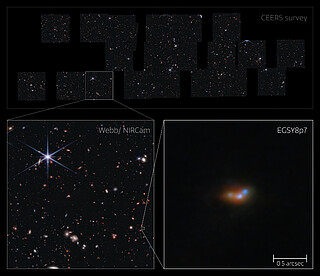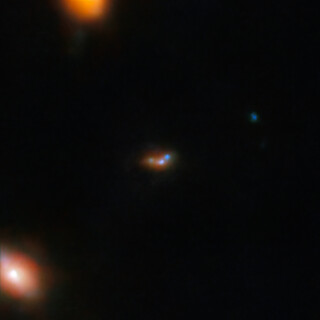weic2402 — Science Release
Webb reveals that galaxy mergers are the solution to early Universe mystery
18 January 2024
One of the key missions of the NASA/ESA/CSA James Webb Space Telescope is to probe the early Universe. Now, the unmatched resolution and sensitivity of Webb’s NIRCam instrument have revealed, for the first time, what lies in the local environment of galaxies in the very early Universe. This has solved one of the most puzzling mysteries in astronomy — why astronomers detect light from hydrogen atoms which should have been entirely blocked by the pristine gas that formed after the Big-Bang. These new Webb observations have found small, faint objects surrounding the very galaxies that show the ‘inexplicable’ hydrogen emission. In conjunction with state-of-the-art simulations of galaxies in the early Universe, the observations have shown that the chaotic merging of these neighbouring galaxies is the source of this hydrogen emission.
Light travels at a finite speed (300 000 kilometres per second), which means that the further away a galaxy is, the longer it has taken the light from it to reach our Solar System. As a result, not only do observations of the most distant galaxies probe the far reaches of the Universe, but they also allow us to study the Universe as it was in the past. In order to study the very early Universe, astronomers require exceptionally powerful telescopes that are capable of observing very distant — and therefore very faint — galaxies. One of Webb’s key capabilities is its ability to observe those very distant galaxies, and hence to probe the early history of the Universe. An international team of astronomers have put Webb’s amazing capacity to excellent use in solving a long-standing mystery in astronomy.
The very earliest galaxies were sites of vigorous and active star formation, and as such were rich sources of a type of light emitted by hydrogen atoms called Lyman-α emission [1]. However, during the epoch of reionisation [2] an immense amount of neutral hydrogen gas surrounded these areas of active star formation (also known as stellar nurseries). Furthermore, the space between galaxies was filled by more of this neutral gas than is the case today. The gas can very effectively absorb and scatter this kind of hydrogen emission [3], so astronomers have long predicted that the abundant Lyman-α emission released in the very early Universe should not be observable today. This theory has not always stood up to scrutiny, however, as examples of very early hydrogen emission have previously been observed by astronomers. This has presented a mystery: how is it that this hydrogen emission — that should have long since been absorbed or scattered — is being observed? Researcher at the University of Cambridge and principal investigator on the new study Callum Witten elaborates:
“One of the most puzzling issues that previous observations presented was the detection of light from hydrogen atoms in the very early Universe, which should have been entirely blocked by the pristine neutral gas that was formed after the Big-Bang. Many hypotheses have previously been suggested to explain the great escape of this ‘inexplicable’ emission.”
The team’s breakthrough came thanks to Webb’s extraordinary combination of angular resolution and sensitivity. The observations with Webb’s NIRCam instrument were able to resolve smaller, fainter galaxies that surround the bright galaxies from which the ‘inexplicable’ hydrogen emission had been detected. In other words, the surroundings of these galaxies appear to be a much busier place than we previously thought, filled with small, faint galaxies. Crucially, these smaller galaxies were interacting and merging with one another, and Webb has revealed that galaxy mergers play an important role in explaining the mystery emission from the earliest galaxies. Sergio Martin-Alvarez, team member from Stanford University, adds:
“Where Hubble was seeing only a large galaxy, Webb sees a cluster of smaller interacting galaxies, and this revelation has had a huge impact on our understanding of the unexpected hydrogen emission from some of the first galaxies.”
The team then used state-of-the-art computer simulations to explore the physical processes that might explain their results. They found that the rapid build-up of stellar mass through galaxy mergers both drove strong hydrogen emission and facilitated the escape of that radiation via channels cleared of the abundant neutral gas. So the high merger rate of the previously unobserved smaller galaxies presented a compelling solution to the long-standing puzzle of the ‘inexplicable’ early hydrogen emission.
The team are planning follow up observations with galaxies at various stages of merging, in order to continue to develop their understanding of how the hydrogen emission is ejected from these changing systems. Ultimately, this will enable them to improve our understanding of galaxy evolution.
These findings have been published today in Nature Astronomy.
Notes
[1] Lyman-α emission is light emitted at a wavelength of 121.567 nanometres when the electron in an excited hydrogen atom drops from an excited state in the n = 2 orbital down to its ground state n = 1 (the lowest energy state the atom can have). Quantum physics dictates that electrons can only exist in very specific energy states, and this means that certain energy transitions — such as when the electron in a hydrogen atom drops from orbital n = 2 to n = 1 — can be identified by the wavelength of the light emitted during that transition. Lyman-α emission is important in many branches of astronomy, partly because hydrogen is so abundant in the Universe, and also because hydrogen is typically excited by energetic processes such as ongoing active star formation. Accordingly, Lyman-α emission can be used as a sign that active star formation is taking place.
[2] The epoch of reionisation was a very early stage in the Universe’s history that took place after recombination (the first stage following the Big Bang). During recombination, the Universe cooled enough that electrons and protons began to combine to form neutral hydrogen atoms. During reionisation, denser clouds of gas started to form, creating stars and eventually entire galaxies whose light gradually reionised the hydrogen gas..
[3] Neutral hydrogen gas is made of hydrogen atoms that are in the lowest energy state they can be, each with their electron in orbital n = 1. Since the light emitted by a hydrogen atom during Lyman-α emission carries the energy of the atomic transition from orbital n = 2 down to n = 1, when it strikes a neutral hydrogen atom, it has exactly the right amount of energy to ionise the atom and take its electron up to the next available orbital. This means the neutral gas absorbs and blocks Lyman-α emission very easily.
More information
Webb is the largest, most powerful telescope ever launched into space. Under an international collaboration agreement, ESA provided the telescope’s launch service, using the Ariane 5 launch vehicle. Working with partners, ESA was responsible for the development and qualification of Ariane 5 adaptations for the Webb mission and for the procurement of the launch service by Arianespace. ESA also provided the workhorse spectrograph NIRSpec and 50% of the mid-infrared instrument MIRI, which was designed and built by a consortium of nationally funded European Institutes (The MIRI European Consortium) in partnership with JPL and the University of Arizona.
Webb is an international partnership between NASA, ESA and the Canadian Space Agency (CSA).
The international team of astronomers in this study consists of: Callum Witten (Institute of Astronomy, University of Cambridge, UK [IoA] and Kavli Institute for Cosmology, University of Cambridge, UK [Kavli]), Nicolas Laporte (Kavli and Cavendish Laboratory, University of Cambridge, UK [Cavendish]) Sergio Martin-Alvarez (Kavli Institute for Particle Astrophysics and Cosmology, Stanford University, USA), Debora Sijacki (IoA and Kavli), Yuxuan Yuan (IoA and Kavli) Martin G. Haehnelt (IoA and Kavli), William M. Baker (Kavli and Cavendish), James S. Dunlop (Institute for Astronomy, University of Edinburgh, Royal Observatory, UK), Richard S. Ellis (Department of Physics and Astronomy, University College London, UK [UCL]), Norman A. Grogin (Space Telescope Science Institute, USA [STScI]), Garth Illingworth (Department of Astronomy and Astrophysics, University of California, Santa Cruz, USA), Harley Katz (Department of Physics, University of Oxford, UK), Anton M. Koekemoer (STScI), Daniel Magee (UCO/Lick Observatory, University of California, Santa Cruz, USA), Roberto Maiolino (Kavli, Cavendish and UCL), William McClymont (Kavli and Cavendish), Pablo G. Pérez-González (Centro de Astrobiología, CSIC-INTA, Spain) Dávid Puskás (Kavli and Cavendish), Guido Roberts-Borsani (Department of Physics and Astronomy, University of California, Los Angeles, USA), Paola Santini (INAF - Osservatorio Astronomico di Roma, Italy), Charlotte Simmonds (Kavli and Cavendish).
Image Credit: ESA/Webb, NASA & CSA, S. Finkelstein (UT Austin), M. Bagley (UT Austin), R. Larson (UT Austin), A. Pagan (STScI), C. Witten, M. Zamani (ESA/Webb)
Links
Contacts
Bethany Downer
ESA/Webb Chief Science Communications Officer
Email: [email protected]
Ninja Menning
ESA Newsroom and Media Relations Office
Email: [email protected]
Callum Witten
University of Cambridge
Email: [email protected]
About the Release
| Release No.: | weic2402 | |
|---|---|---|





